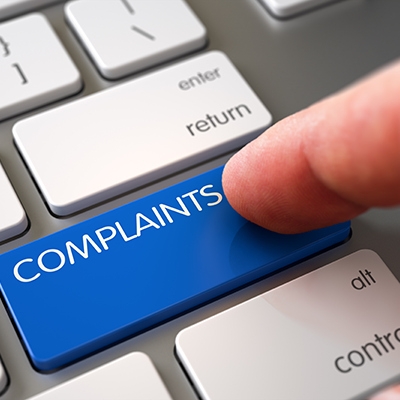One of the most important responsibilities of HRPA is to ensure our registrants (members, students, registered firms) are practicing HR competently, professionally, and ethically – and in accordance with the Code of Ethics and Rules of Professional Conduct.
So, if you believe that an HRPA registrant has failed to meet their professional obligations under the Code of Ethics and Rules of Professional Conduct, we’re here to help.
Here are the top questions and answers about filing a complaint:
HRPA can only investigate a complaint filed against a registrant of the HRPA. To find out if an individual is a registrant of the HRPA, use the HRPA Public Register or contact the Office of the Registrar at registrar@hrpa.ca
True, anyone can file a complaint, including a member of the public (employee or employer), a fellow HRPA registrant or the Registrar on behalf of the HRPA.
But, unfortunately, we can’t investigate complaints against non-registrants and they must be directed to authorities other than the HRPA.
(However, if you come across an HR professional who is not registered with HRPA but claims to be, HRPA has the authority to stop this individual from making this false claim.)
Filing a complaint can be scary, especially if the complaint is against an HR professional within your organization. As such, it can be tempting to contact HRPA anonymously to raise concerns regarding a registrant’s professional conduct. Unfortunately, while we will consider anonymous complaints, in most cases there is not much we can do with an anonymous complaint.
Anonymous complaints are challenging for a variety of reasons:
- There is no opportunity to ask follow-up or clarification questions, or to seek further information.
- There may be no or limited supporting documentation/evidence that is submitted with the anonymous complaint.
- There are usually no witnesses to rely on.
As a result, whenever HRPA receives an anonymous complaint we have to balance the fact that potential misconduct has been brought to our attention with procedural fairness to the registrant – specifically the requirement that the registrant should know the case against them and have the opportunity to respond fully.
When we do receive an anonymous complaint, we will review it on its merits to determine the best way to approach the matter, but in most circumstances our options will be limited to sending a letter to the Registrant advising them of the allegations.
So, if you’re considering filing a complaint, we would strongly encourage you to file an official complaint to ensure the matter can be fully investigated and addressed.
Step 1: Registrant is Notified of the Complaint: Your complaint is reviewed by HRPA’s Office of the Registrar for completeness and then a copy of the complaint is sent to the registrant who is the subject of the complaint. (Your contact information is not included in the copy sent to the Registrant – only your name.)
Step 2: All Parties Can Review and Respond to the Complaint: The registrant who is the subject of the complaint has 30 days to submit a response to the complaint, which is then shared with you. You may respond to the registrant’s response within 14 days to either refute statements made by the registrant, or address any new issue raised by the registrant. Any response from you be shared with the registrant, who will be provided with the same opportunity to respond to your second submission within 14 days.
Step 3: The Complaint is Reviewed by the Complaints Committee: Once both you and the registrant have had the opportunity to make your submissions, the Chair of the Complaints Committee appoints a panel to consider the complaint. At that point, the Panel of the Complaints Committee will review the complaint and may decide that the matter requires further investigation.
What happens during an investigation? To maintain fairness for all parties, the complaints and investigation process is kept confidential. However, information about complaints cases is anonymized and disclosed in quarterly Registrar Reports and the Regulatory Affairs newsletter. HRPA publishes disciplinary actions and includes these in the public registry.
Step 4: The Complaints Committee Makes a Decision: Once the Complaints Committee Panel weighs all the evidence, a decision is made. Here are one or more of the possible outcomes:
- Complaint is dismissed.
- Registrant must go before the Panel to receive caution or admonishment.
- There’s a tentative settlement agreement between HRPA and the registrant that’s negotiated and referred to the Discipline Committee for approval.
- Complaint (or parts of the complaint) is directed to the Discipline Committee. After that, a Notice of Hearing will be given to the registrant, who is the subject of the complaint.
No matter the outcome, both you and the registrant will be notified about the Complaint Committee’s decision and the reasons for that decision.
The Discipline Committee is tasked with hearing all allegations of professional misconduct or incompetence referred to it from the Complaints Committee, deliberate on those matters and apply the appropriate and just remedy to the Registrant who is the subject of the allegation(s).
The Complaints Committee will refer a matter to the Discipline Committee if their investigation leads them to believe that the allegations in a complaint are, in fact, professional misconduct or incompetence.
If the Complaints Committee decides to refer the matter to discipline, then the matter is considered to still be ongoing and you or the registrant would have to wait until the outcome of the discipline proceeding to take any further steps.
If the Complaints Committee makes any other decision that doesn’t involve a referral to discipline, then you or the registrant can request a review of the Complaints Committee’s decision by the Appeal Committee. The request for an appeal must be made within 30 calendar days of the Complaints Committee’s decision.
For more information about the Complaint Process, visit https://www.hrpa.ca/protecting-the-public/register-a-complaint/
